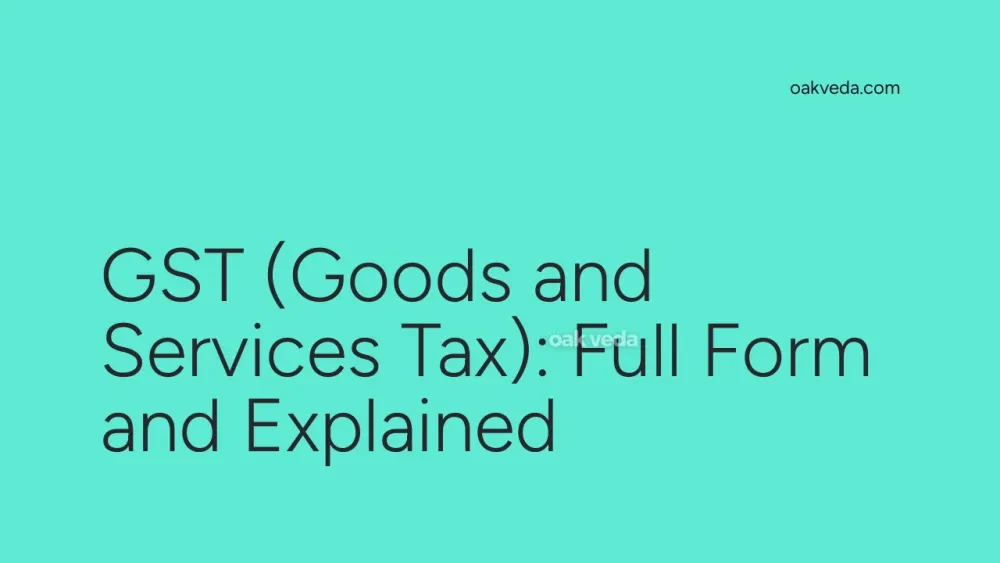
What is the Full Form of GST?
The full form of GST is Goods and Services Tax. This comprehensive indirect tax system was introduced in India to streamline the country's complex tax structure and promote economic growth.
What is Goods and Services Tax?
Goods and Services Tax, commonly known as GST, is a unified indirect tax levied on the supply of goods and services across India. It replaced multiple indirect taxes previously imposed by the central and state governments, simplifying the tax structure and creating a common national market.
Origin and Development of GST
The concept of GST in India has its roots in the early 2000s. After years of deliberation and planning, the GST Act was passed in Parliament on March 29, 2017. The tax officially came into effect on July 1, 2017, marking a significant milestone in India's economic reforms.
How does GST work?
GST operates on the principle of "one nation, one tax." It is a destination-based tax, meaning that the tax is collected at the point of consumption rather than the point of origin. This system ensures that the tax burden is distributed more evenly and reduces the cascading effect of taxes.
Types of GST
There are three main types of GST in India:
-
Central Goods and Services Tax (CGST): This tax is levied on intrastate supply of goods and services by the central government.
-
State Goods and Services Tax (SGST): Imposed by state governments on intrastate supply of goods and services.
-
Integrated Goods and Services Tax (IGST): Applicable to interstate transactions and imports, this tax is collected by the central government and then distributed to the respective states.
Functions of GST
The primary functions of GST include:
- Unifying various indirect taxes under a single system
- Eliminating the cascading effect of taxes
- Simplifying tax compliance for businesses
- Increasing tax revenue for the government
- Promoting transparency in the taxation process
Applications of GST
GST applies to a wide range of goods and services, including:
- Manufactured products
- Services provided by businesses
- Imports and exports
- E-commerce transactions
However, certain items are exempt from GST, such as:
- Basic food items
- Healthcare services
- Educational services
- Certain financial services
Features of GST
Key features of the GST system include:
- Input Tax Credit: Businesses can claim credit for taxes paid on inputs, reducing the overall tax burden.
- Online Compliance: GST returns and payments are managed through a centralized online portal.
- Composition Scheme: Small businesses can opt for a simplified tax structure with lower compliance requirements.
- E-way Bill System: Electronic documentation for the movement of goods across state borders.
Benefits of GST
The implementation of GST has brought several benefits to the Indian economy:
- Simplified Tax Structure: GST has replaced multiple indirect taxes, making compliance easier for businesses.
- Reduced Tax Burden: The elimination of tax-on-tax has lowered the overall tax burden on goods and services.
- Increased Competitiveness: A unified tax system has made Indian products more competitive in the global market.
- Improved Tax Collection: GST has led to better tax compliance and increased revenue for the government.
- Boost to E-commerce: The simplified tax structure has facilitated the growth of online businesses.
Limitations or Challenges of GST
Despite its benefits, GST implementation has faced some challenges:
- Initial Complexity: Businesses, especially small enterprises, faced difficulties in adapting to the new system.
- Technology Dependence: The GST system relies heavily on technology, which can be challenging for businesses in rural areas.
- Frequent Rate Changes: Adjustments to GST rates have caused confusion and compliance issues for some sectors.
- Impact on Certain Industries: Some industries, like textiles and real estate, have faced challenges due to GST implementation.
Future Developments in GST Technology
The GST system continues to evolve, with ongoing efforts to improve its efficiency and effectiveness:
- Artificial Intelligence: AI-powered systems are being developed to detect tax evasion and improve compliance.
- Blockchain Integration: Blockchain technology may be used to enhance the security and transparency of GST transactions.
- Simplified Returns: The government is working on introducing a more streamlined return filing process.
- Real-time Invoice Matching: Advanced systems for real-time invoice matching are being explored to reduce fraud and improve tax collection.
FAQs on GST Full Form
-
What is the full form of GST? The full form of GST is Goods and Services Tax.
-
When was GST implemented in India? GST was implemented in India on July 1, 2017.
-
What are the three main types of GST? The three main types of GST are CGST (Central GST), SGST (State GST), and IGST (Integrated GST).
-
Are all goods and services subject to GST? No, certain items like basic food products, healthcare services, and educational services are exempt from GST.
-
How has GST impacted the Indian economy? GST has simplified the tax structure, reduced tax burden, increased competitiveness of Indian products, and improved tax collection.
In conclusion, the Goods and Services Tax (GST) has been a transformative reform in India's taxation system. While it has faced challenges, its benefits in simplifying the tax structure and promoting economic growth are significant. As the system continues to evolve, it is expected to play a crucial role in India's economic development in the years to come.
You may be interested in:

